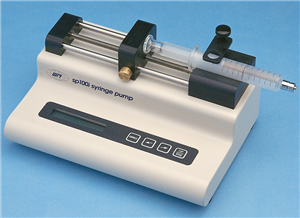

SP100iZ
Single-Syringe Infusion Pump
- Overview
- Specifications
- Accessories
- Citations
- Related Products
Overview

There are 1 images available to view - click to enlarge and scroll through the product gallery.
Manual
/ Download as PDF
- Accepts syringe sizes: 10uL - 50mL
- Minimum Flow Rate: 0.1 uL/hr (10 uL syringe)
- Maximum Flow Rate: 519 mL/hr (60 mL syringe)
- 220-240 V, 50 Hz
Sturdy, reliable, and easy to use
Sturdy and reliable, extremely simple to set up and use - and surprisingly affordable. Liquid crystal displays (LCDs) prompt you through setup: First, select syringe from table stored in the pump's memory and displayed on the LCD. Next, enter the volume to be dispensed. Finally, enter the flow rate, press "start." It's fast and simple. Your settings are permanently stored in memory - there's no need to re-enter them each day. SP pumps feature preset rate and volume control. Just set the volume you want dispensed. Volume is tracked continuously on the LCD display. Then, when the preset volume has been dispensed, the pump shuts off automatically. The easy-to-read digital display provides realtime readings using both parameters and values for clearer, mistake-free readings.
Features
This inexpensive single-syringe infusion pump combines precision and simplicity with outstanding ease of use and durability. Its features include automatic volume control and shutoff, simple menu-driven setup: dispense volume, dispense flow rate, syringe diameter (selected from displayed table), Last settings stored in permanent memory, and continuous dispense volume display.
| Syringe | Diameter | Minimum | Maximum |
|---|---|---|---|
| 10 µl | 0.46 mm | 0.1 µl/hr | 126.5 µl/hr |
| 25 µl | 0.73 mm | 0.1 µl/hr | 318.8 µl/hr |
| 50 µl | 1.03 mm | 0.2 µl/hr | 625 µl/hr |
| 100 µl | 1.46 mm | 1 µl/hr | 1274 µl/hr |
| 250 µl | 2.3 mm | 2 µl/hr | 3164 µl/hr |
| 500 µl | 3.26 mm | 3 µl/hr | 6359 µl/hr |
| 1 ml | 4.61 mm | 0.01 ml/hr | 13.2 ml/hr |
| 2.5 ml | 7.28 mm | 0.02 ml/hr | 31.7 ml/hr |
| 3 ml | 8.59 mm | 0.02 ml/hr | 44.9 ml/hr |
| 5 ml | 10.3 mm | 0.03 ml/hr | 87.0 ml/hr |
| 10 ml | 14.57 mm | 0.1 ml/hr | 125.0 ml/hr |
| 20 ml | 19.05 mm | 0.1 ml/hr | 219.0 ml/hr |
| 30 ml | 21.59 mm | 0.1 ml/hr | 282.0 ml/hr |
| 50 ml | 28.9 mm | 0.2 ml/hr | 503.2 ml/hr |
| 60 ml | 26.6 mm | 0.2 ml/hr | 426.0 ml/hr |
Specifications
| Mode | Infusion |
| Syringe Size | 10 µL to 60 mL (one) |
| Maximum Flow Rate (60 mL Syringe) | 519 mL/hr |
| Minimum Flow Rate (10 µL Syringe) | 0.1µL/hr |
| Linear Force | 20 Ib (9 kg) |
| Advance Per Microstep | 0.529 micron (1/2-step) |
| Maximum Step Rate (1/2-step) | 400 steps/sec |
| Minimum Step Rate | 1 step/30 sec |
| Accuracy | < 1% error |
| Reproducibility | ± 0.1% |
| Dimensions | 9 x 6 x 5.5 in., 23 x 15 x 14 cm |
| Shipping Weight | 7.5 Ib (3.4 kg) |
| Notes: | Available 95-135 V or 220-240 V, 50/60 Hz |
Accessories
Citations
Avilés-Rosas, V. H., Rivera-Mancilla, E., Marichal-Cancino, B. A., Manrique-Maldonado, G., Altamirano-Espinoza, A. H., Maassen Van Den Brink, A., & Villalón, C. M. (2017). Olcegepant blocks neurogenic and non-neurogenic CGRPergic vasodepressor responses and facilitates noradrenergic vasopressor responses in pithed rats. British Journal of Pharmacology, 174(13), 2001–2014. http://doi.org/10.1111/bph.13799
García-Pedraza, J. Á., Hernández-Abreu, O., García, M., Morán, A., & Villalón, C. M. (2018). Chronic 5-HT 2 receptor blockade unmasks the role of 5-HT 1F receptors in the inhibition of rat cardioaccelerator sympathetic outflow. Canadian Journal of Physiology and Pharmacology, 96(4), 328–336. http://doi.org/10.1139/cjpp-2017-0191
Rubio-Beltrán, E., Labastida-Ramírez, A., Hernández-Abreu, O., MaassenVanDenBrink, A., & Villalón, C. M. (2017). Pharmacological analysis of the inhibition produced by moxonidine and agmatine on the vasodepressor sensory CGRPergic outflow in pithed rats. European Journal of Pharmacology, 812, 97–103. http://doi.org/10.1016/J.EJPHAR.2017.07.020
Centurión, D., de la Cruz, S. H., Castillo-Santiago, S. V., Becerril-Chacón, M. E., Torres-Pérez, J. A., & Sánchez-López, A. (2018). NaHS prejunctionally inhibits the cardioaccelerator sympathetic outflow in pithed rats. European Journal of Pharmacology, 823, 35–40. http://doi.org/10.1016/J.EJPHAR.2018.01.030
Xu, F., Xu, C., Ding, L., Zhou, M., & Ding, C.-F. (2018). Enhancement of ion activation and collision induced dissociation by direct current potential in digital ion trap mass spectrometer. International Journal of Mass Spectrometry, 428, 29–34. http://doi.org/10.1016/J.IJMS.2018.02.004
Alarcón, P., Manosalva, C., Conejeros, I., Carretta, M. D., Muñoz-Caro, T., Silva, L. M. R., … Burgos, R. A. (2017). d(−) Lactic Acid-Induced Adhesion of Bovine Neutrophils onto Endothelial Cells Is Dependent on Neutrophils Extracellular Traps Formation and CD11b Expression. Frontiers in Immunology, 8, 975. http://doi.org/10.3389/fimmu.2017.00975
He, J., Guo, R., Qiu, P., Su, X., Yan, G., & Feng, J. (2017). Exogenous hydrogen sulfide eliminates spatial memory retrieval impairment and hippocampal CA1 LTD enhancement caused by acute stress via promoting glutamate uptake. Neuroscience, 350, 110–123. http://doi.org/10.1016/J.NEUROSCIENCE.2017.03.018





Request
Catalogue
Chat
Print